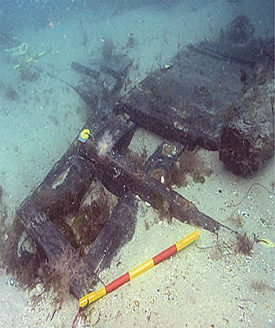
Project Introduction
15 June 2010
By Dave Parham
Work first began on the Swash Channel Wreck in 2006, chiefly by students from Bournemouth University. Since then the site is being rapidly exposed by natural processes that are eroding its covering of sand and exposing archaeological material to rapid mechanical and biological degradation.

Swash Channel Wreck forecastle showing the top rail (photograph courtesy of Bournemouth University).
The decision made by English Heritage to fund a rescue excavation of the sections of the wreck most at risk followed on evidence that this is a rare and historically important survival, a large, likely high status northwest European armed merchant ship. It was wrecked in the approaches to Poole Harbour c. 1630. Evidence so far points to it being involved in international trade, most likely the tropics. Such activity marks the beginning of north-western European exploitation of connections developed during the voyages of discovery of the 16th century.
The wreck is one of only a handful of wreck sites where the physical remains of one the ships involved in this emerging trade survive, with almost 40% of the port side of originating ship being present. The majority of the port side of the forecastle survives. The structure includes at least one carving which is situated at the forward edge, currently buried face down (and therefore protected). This is an extremely rare survival as the ship's forecastle is usually swept away in the wrecking process. No other carvings of this date are known to exist on UK Protected Wreck Sites.
Return to MUA Project Journals home page.

